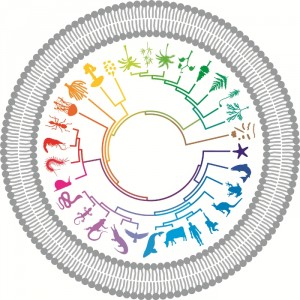
Edouard Van Beneden and Theodor Boveri first described the centrosome as “the organ for cell division” in the 1880s, so you might think it is an essential component of cells. Not so, according to Monica Bettencourt-Dias in her Question and Answer article in BMC Biology, where she assembles accumulating recent evidence that despite its apparent ubiquity in animals and classical appearance at the poles of the mitotic spindle, it’s optional. This is particularly surprising because in the course of the hundred-plus years since Beneden and Boveri, it has become clear that centrosomes also function in the positioning of the microtubule cytoskeleton in non-dividing cells in which they play a part in motility, signalling, protein traffic and other important activities. So what do we now understand of the function of the centrosome?
Critical to the answer are the two microtubule-based centrioles at the structural heart of the centrosome, which otherwise consists of an amorphous matrix known as the pericentriolar material, or PCM. It is well known that the centrosome acts as a microtubule organizing center, with its textbook role in forming mitotic spindles in dividing cells. So in many cells, the centrosome with its centrioles is indeed essential to ensure correct cell division, and in these the PCM ensures the distribution of the right number of centrioles to each daughter cell. But there are exceptions – which include somatic cells in fruit flies and some fungi – where no centrioles are needed; and centrosomes in some differentiated cells, including neurons and muscle cells, are inactive.
Centrioles, on the other hand, are essential in almost all organisms, at least if they need cilia (which most do) or flagella. Centrioles form the basal ‘unit’ of cilia and flagella, and there is no organism that has cilia or flagella but no centrioles. Flatworms (planarians), which have no centrosomes, assemble centrioles de novo in cells with cilia. Is the nucleation of cilia the ancestral function of the centriole, from which centrosomes secondarily derived? Read the article and see what you think.
Many other questions remain. We have yet to understand the role of the pericentriolar material, in which many different protein components have been identified, without yet yielding clear understanding of the part they play. How component proteins regulate the striking “cartwheel” structure of the centriole that gives rise to its nine-fold symmetry is also a puzzle yet to be solved.
How is the length of a centriole limited? What happens when centrosome-related structures do not form properly? This is the last question tackled by Bettencourt-Dias in her Q&A article, giving insight into diseases of the brain and cancers, as well as developmental defects.
This Q&A forms part of BMC Biology’s series on cell geometry. BMC Biology welcomes submissions that may help to answer these outstanding questions.
Latest posts by Ann Le Good (see all)
- Embryonic transformations - 19th January 2015
- Questioning regeneration: answers from Alejandro Sánchez-Alvarado - 29th October 2014
- How do geckos climb? - 15th May 2014
Comments